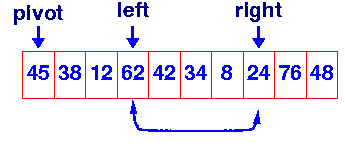7 Radix Sorting
The bin sorting approach can be generalised in a technique that
is known as
radix sorting.
An example
Assume that we have
n integers in the range (0,
n2)
to be sorted.
(For a bin sort,
m =
n2, and
we would have an
O(n+m) =
O(n2) algorithm.)
Sort them in two phases:
- Using n bins, place ai into bin
ai mod n,
- Repeat the process using n bins,
placing ai into bin
floor(ai/n),
being careful to append to the end of each bin.
This results in a sorted list.
As an example, consider the list of integers:
36 9 0 25 1 49 64 16 81 4
n is 10 and the numbers all lie in (0,99).
After the first phase, we will have:
| Bin | 0 | 1 |
2 | 3 |
4 | 5 |
6 | 7 |
8 | 9 |
|---|
| Content |
0 |
1
81 | - | - |
64
4 |
25 |
36
16 |
- |
- |
9
49 |
Note that in this phase, we placed each item in a bin indexed by the
least significant decimal digit.
Repeating the process, will produce:
| Bin | 0 | 1 |
2 | 3 |
4 | 5 |
6 | 7 |
8 | 9 |
|---|
| Content |
0
1
4
9 |
16 |
25 |
36 |
49 |
- |
64 |
- |
81 |
- |
In this second phase, we used the leading decimal digit to allocate items
to bins, being careful to add each item to the end of the bin.
We can apply this process to numbers of any size expressed to any suitable
base or
radix.
7.5.1 Generalised Radix Sorting
We can further observe that it's not necessary to use the same radix
in each phase, suppose that the sorting key is a sequence of
fields, each with bounded ranges,
eg the key is a date using the structure:
typedef struct t_date {
int day;
int month;
int year;
} date;
If the ranges for
day and
month are limited in the obvious way,
and the range for
year
is suitably constrained,
eg 1900 <
year <= 2000,
then we can apply the same procedure except that we'll employ a
different number of bins in each phase.
In all cases, we'll sort first using the least significant "digit"
(where "digit" here means a field with a limited range), then
using the next significant "digit", placing each item after all the items
already in the bin, and so on.
Assume that the key of the item to be sorted has
k fields,
fi|
i=0..
k-1,
and that each
fi has
si
discrete values,
then a generalised radix sort procedure can be written:
radixsort( A, n ) {
for(i=0;i<k;i++) {
for(j=0;j<si;j++) bin[j] = EMPTY;
|
O(si) |
for(j=0;j<n;j++) {
move Ai
to the end of bin[Ai->fi]
}
|
O(n) |
for(j=0;j<si;j++)
concatenate bin[j] onto the end of A;
}
}
|
O(si) |
| Total |
 |
Now if, for example, the keys are integers in (0,
bk-1),
for some constant
k,
then the keys can be viewed as
k-digit base-
b integers.
Thus,
si = b for all
i and
the time complexity becomes
O(n+kb) or
O(n).
This result depends on k being constant.
If
k is allowed to increase with
n,
then we have a different picture.
For example,
it takes
log
2n
binary digits to represent an integer <
n.
If the key length were allowed to increase with
n,
so that
k = log
n,
then we would have:

.
Another way of looking at this is to note that if the range of the
key is restricted to
(0,
bk-1),
then we will be able to use the radixsort approach effectively
if we allow duplicate keys when n>bk.
However, if we need to have unique keys,
then
k must increase to at least
log
bn.
Thus, as
n increases, we need to have log
n phases,
each taking
O(n) time,
and the radix sort is the same as quick sort!
Sample code
This sample code sorts arrays of integers on various radices:
the number of bits used for each radix can be set with the
call to SetRadices. The
Bins class is used in each
phase to collect the items as they are sorted.
ConsBins is called to set up a set of bins:
each bin must be large enough to accommodate the whole array,
so RadixSort can be very expensive in its memory usage!



 .
.
